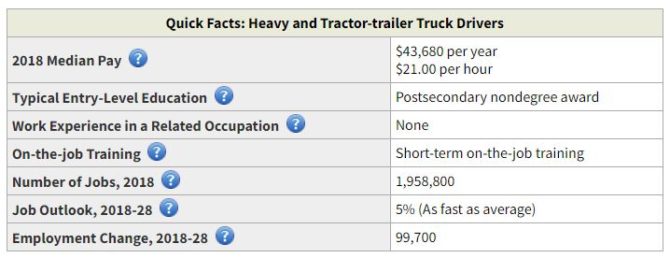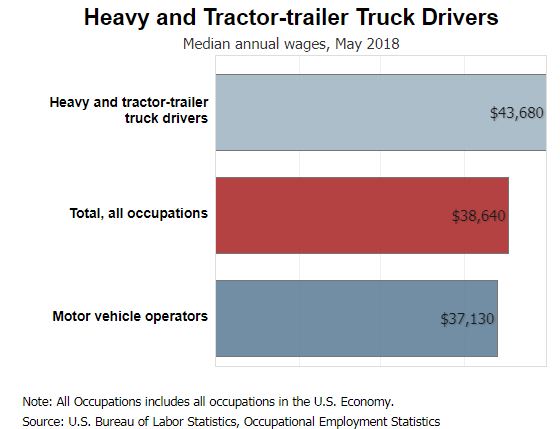Truck Driver

Heavy and tractor-trailer truck drivers transport goods from one location to another. Most tractor-trailer drivers are long-haul drivers and operate trucks with a total weight exceeding 26,000 pounds for the vehicle, passengers, and cargo. These drivers deliver goods over intercity routes that sometimes span several states.
Heavy and tractor-trailer truck drivers typically do the following:
- Drive long distances
- Report any incidents encountered on the road to a dispatcher
- Follow all applicable traffic laws
- Secure cargo for transport, using ropes, blocks, chains, or covers
- Inspect their trailers before and after the trip and record any defects they find
- Maintain a log of their working hours, following all federal and state regulations
- Report serious mechanical problems to the appropriate people
- Keep their trucks and associated equipment clean and in good working order
Most heavy and tractor-trailer truck drivers’ routes are assigned by a dispatcher, but some independent drivers still plan their own routes. When planning routes, drivers must take into account any road restrictions that prohibit large trucks. Drivers also must plan legally required rest periods into their trip.
Some drivers have one or two routes that they drive regularly, and other drivers take many different routes throughout the country. In addition, some drivers have routes that include Mexico or Canada.
Companies sometimes use two drivers, known as teams, on long runs to minimize downtime. On these team runs, one driver sleeps in a berth behind the cab while the other drives.
Certain cargo requires drivers to adhere to additional safety regulations. Some heavy truck drivers who transport hazardous materials, such as chemical waste, must take special precautions when driving and may carry specialized safety equipment in case of an accident. Other drivers, such as those carrying liquids, oversized loads, or cars, must follow rules that apply specifically to them.
Some long-haul truck drivers, also called owner-operators, buy or lease trucks and go into business for themselves. In addition to their driving tasks, owner-operators have business tasks, including finding and keeping clients and doing administrative work.
Heavy and tractor-trailer truck drivers held about 2.0 million jobs in 2018. The largest employers of heavy and tractor-trailer truck drivers were as follows:
| Truck transportation | 45% |
| Wholesale trade | 11 |
| Manufacturing | 7 |
| Self-employed workers | 6 |
| Construction | 6 |
Working as a long-haul truck driver is a lifestyle choice because these drivers can be away from home for days or weeks at a time. They spend much of this time alone. Driving a truck can be a physically demanding job as well. Driving for many consecutive hours can be tiring, and some drivers must load and unload cargo.
Injuries and Illnesses
Because of the potential for traffic accidents, heavy and tractor-trailer truck drivers have one of the highest rates of injuries and illnesses of all occupations.
Work Schedules
Most heavy tractor-trailer drivers work full time. The Federal Motor Carrier Safety Administration regulates the hours that a long-haul truck driver may work. Drivers may not work more than 14 hours straight, comprising up to 11 hours driving and the remaining time doing other work, such as unloading cargo. Between working periods, drivers must have at least 10 hours off duty. Drivers also are limited to driving no more than 60 hours within 7 days or 70 hours within 8 days; then drivers must take 34 hours off before starting another 7- or 8-day run. Drivers must record their hours in a logbook. Truck drivers often work nights, weekends, and holidays.
Heavy and tractor-trailer truck drivers usually have a high school diploma and attend a professional truck driving school. They must have a commercial driver’s license (CDL).
Education
Most companies require their truck drivers to have a high school diploma or equivalent.
Many prospective drivers attend professional truck driving schools, where they take training courses to learn how to maneuver large vehicles on highways or through crowded streets. During these classes, drivers also learn the federal laws and regulations governing interstate truck driving. Students may attend either a private truck-driving school or a program at a community college that lasts between 3 and 6 months.
Upon finishing their classes, drivers receive a certificate of completion.
Licenses, Certifications, and Registrations
All long-haul truck drivers must have a commercial driver’s license (CDL). Qualifications for obtaining a CDL vary by state but generally include passing both a knowledge test and a driving test. States have the right to refuse to issue a CDL to anyone who has had a CDL suspended by another state.
Drivers can get endorsements to their CDL that show their ability to drive a specialized type of vehicle. Truck drivers transporting hazardous materials (HAZMAT) must have a hazardous materials endorsement (H). Getting this endorsement requires passing an additional knowledge test and a background check.
Federal regulations require CDL drivers to maintain a clean driving record and pass a physical exam every two years. They are also subject to random testing for drug or alcohol abuse. Truck drivers can have their CDL suspended if they are convicted of driving under the influence of alcohol or drugs or are convicted of a felony involving the use of a motor vehicle.
Other actions can result in a suspension after multiple violations. The Federal Motor Carrier Safety Administration website has a list of these violations. Additionally, some companies have stricter standards than what federal regulations require.
Training
After completing truck-driving school and being hired by a company, drivers normally receive several weeks of on-the-job training. During this time, they drive a truck accompanied by an experienced mentor-driver in the passenger seat. This period of on-the-job training is given so that the new drivers will learn more about the specific type of truck they will drive and material they will transport.
Important Qualities
Hand-eye coordination. Drivers of heavy trucks and tractor-trailers must be able to coordinate their legs, hands, and eyes simultaneously so that they will react appropriately to the situation around them and drive the vehicle safely.
Hearing ability. Truck drivers need good hearing. Federal regulations require that a driver be able to hear a forced whisper in one ear at 5 feet away (with or without the use of a hearing aid).
Physical health. Federal regulations do not allow people to become truck drivers if they have a medical condition, such as high blood pressure or epilepsy, which may interfere with their ability to operate a truck. The Federal Motor Carrier Safety Administration website has a full list of medical conditions that disqualify someone from driving a long-haul truck.
Visual ability. Truck drivers must be able to pass vision tests. Federal regulations require a driver to have at least 20/40 vision with a 70-degree field of vision in each eye and the ability to distinguish the colors on a traffic light.

The median annual wage for heavy and tractor-trailer truck drivers was $43,680 in May 2018. The median wage is the wage at which half the workers in an occupation earned more than that amount and half earned less. The lowest 10 percent earned less than $28,160, and the highest 10 percent earned more than $65,260.
In May 2018, the median annual wages for heavy and tractor-trailer truck drivers in the top industries in which they worked were as follows:
| Truck transportation | $45,000 |
| Wholesale trade | 42,960 |
| Construction | 41,650 |
| Manufacturing | 41,280 |
Drivers of heavy trucks and tractor-trailers usually are paid by how many miles they have driven, plus bonuses. The per-mile rate varies from employer to employer and may depend on the type of cargo and the experience of the driver. Some long-distance drivers, especially owner-operators, are paid a share of the revenue from shipping.
Most heavy tractor-trailer drivers work full time. The Federal Motor Carrier Safety Administration regulates the hours that a long-haul truck driver may work. Drivers may not work more than 14 hours straight, comprising up to 11 hours driving and the remaining time doing other work, such as unloading cargo. Between working periods, drivers must have at least 10 hours off duty. Drivers also are limited to driving no more than 60 hours within 7 days or 70 hours within 8 days; then drivers must take 34 hours off before starting another 7- or 8-day run. Drivers must record their hours in a logbook. Truck drivers often work nights, weekends, and holidays.
Employment of heavy and tractor-trailer truck drivers is projected to grow 5 percent from 2018 to 2028, about as fast as the average for all occupations.

The economy depends on truck drivers to transport freight and keep supply chains moving. As the demand for goods increases, more truck drivers will be needed. Trucks transport most of the freight in the United States, so, as households and businesses increase their spending, the trucking industry should grow.
Technological advancements should result in trucks that are more fuel efficient and easier to drive. For example, automatic transmissions, blindspot monitoring, braking assistance, and variable cruise control are all recently developed features that may become more standard throughout the trucking industries within the next decade. In addition, technological advances may lead to further developments in platooning, which is a method of transport where several trucks form a line and automatically mimic the speed, braking, and steering behaviors of the lead truck. These technologies can help ease driver burden and create a safer driving environment for all vehicles.
Job Prospects
Job prospects are projected to be very good for heavy and tractor-trailer truck drivers with the proper training and a clean driving record. Because of truck drivers’ difficult lifestyle and time spent away from home, many companies have trouble finding and retaining qualified long-haul drivers. In addition, many truck drivers are expected to retire in the coming years, creating even more job opportunities.
Bureau of Labor Statistics, U.S. Department of Labor, Occupational Outlook Handbook, Heavy and Tractor-trailer Truck Drivers,
on the Internet at https://www.bls.gov/ooh/transportation-and-material-moving/heavy-and-tractor-trailer-truck-drivers.htm (visited December 13, 2019).
Salary information comes from the Bureau of Labor Statistics, Occupational Employment Statistics Program, a semi-annual survey that provides wage and employment statistics for the nation, each state, and sub-state regions.
Tagged as AC, Affiliated Foods, Amarillo College, Career, CDL, Clarendon College, Commercial Driver's License, Education, Frank Phillips College, Hometown Success, Jobs Ya'll, Long-Haul, Occupation, Plains Transportation Inc, Region 16, Texas, Texas Panhandle, Texas Workforce Commission, Transportation and Material Moving Occupations, Truck Driver, Truck Driving, West Texas A&M University, Workforce Solutions Panhandle.
Written by Angela









